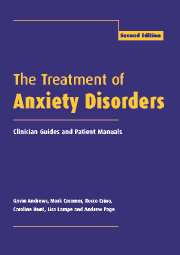Book contents
- Frontmatter
- Contents
- List of authors
- Preface to the second edition
- Abbreviations
- 1 Read me
- 2 General issues in anxiety disorders
- 3 General issues in treatment: Clinician Guide
- 4 Panic disorder and agoraphobia: Syndrome
- 5 Panic disorder and agoraphobia: Treatment
- 6 Panic disorder and agoraphobia: Clinician Guide
- 7 Panic disorder and agoraphobia: Patient Treatment Manual
- 8 Social phobia: Syndrome
- 9 Social phobia: Treatment
- 10 Social phobia: Clinician Guide
- 11 Social phobia: Patient Treatment Manual
- 12 Specific phobias: Syndrome
- 13 Specific phobias: Treatment
- 14 Specific phobias: Clinician Guide
- 15 Specific phobias: Patient Treatment Manual
- 16 Obsessive-compulsive disorder: Syndrome
- 17 Obsessive-compulsive disorder: Treatment
- 18 Obsessive-compulsive disorder: Clinician Guide
- 19 Obsessive-compulsive disorder: Patient Treatment Manual
- 20 Generalized anxiety disorder: Syndrome
- 21 Generalized anxiety disorder: Treatment
- 22 Generalized anxiety disorder: Clinician Guide
- 23 Generalized anxiety disorder: Patient Treatment Manual
- 24 Posttraumatic stress disorder: Syndrome
- 25 Posttraumatic stress disorder: Treatment
- 26 Posttraumatic stress disorder: Clinician Guide
- 27 Posttraumatic stress disorder: Patient Treatment Manual
- 28 Conclusions
- References
- Index
Preface to the second edition
Published online by Cambridge University Press: 05 August 2016
- Frontmatter
- Contents
- List of authors
- Preface to the second edition
- Abbreviations
- 1 Read me
- 2 General issues in anxiety disorders
- 3 General issues in treatment: Clinician Guide
- 4 Panic disorder and agoraphobia: Syndrome
- 5 Panic disorder and agoraphobia: Treatment
- 6 Panic disorder and agoraphobia: Clinician Guide
- 7 Panic disorder and agoraphobia: Patient Treatment Manual
- 8 Social phobia: Syndrome
- 9 Social phobia: Treatment
- 10 Social phobia: Clinician Guide
- 11 Social phobia: Patient Treatment Manual
- 12 Specific phobias: Syndrome
- 13 Specific phobias: Treatment
- 14 Specific phobias: Clinician Guide
- 15 Specific phobias: Patient Treatment Manual
- 16 Obsessive-compulsive disorder: Syndrome
- 17 Obsessive-compulsive disorder: Treatment
- 18 Obsessive-compulsive disorder: Clinician Guide
- 19 Obsessive-compulsive disorder: Patient Treatment Manual
- 20 Generalized anxiety disorder: Syndrome
- 21 Generalized anxiety disorder: Treatment
- 22 Generalized anxiety disorder: Clinician Guide
- 23 Generalized anxiety disorder: Patient Treatment Manual
- 24 Posttraumatic stress disorder: Syndrome
- 25 Posttraumatic stress disorder: Treatment
- 26 Posttraumatic stress disorder: Clinician Guide
- 27 Posttraumatic stress disorder: Patient Treatment Manual
- 28 Conclusions
- References
- Index
Summary
The first edition of this book was developed from the Patient Treatment Manuals that had been used in the Clinical Research Unit for Anxiety and Depression for the treatment of patients with anxiety disorders. Specialized treatment programs for anxiety disorders were initiated in 1978 modeled on the treatment program for adult stutterers with which Dr. Andrews had long been associated. John Franklin designed and tested the first program for patients with agoraphobia in 1979. Since then programs for panic disorder and agoraphobia, social phobia, specific phobias, generalized anxiety disorder, and obsessive–compulsive disorder have been developed and tested. During these 20 years, many people have contributed to the redevelopment and testing of the Manuals for the various programs. Significant contributions have been made by previous staff members of the unit, in particular John Franklin, Paul Friend, Stephen MacMahon, Richard Mattick, Carmen Moran, Conrad Newman, Susan Tanner, and Morison Tarrant. Robin Harvey was the administrator of the Unit. Advice about the first edition of this book was forthcoming from Alex Blaszczynski, Anette Johansson, Colin MacLeod, Richard Mattick, Hugh Morgan, Michael Nicholas, Cindy Page, Ron Rapee, Mark Ryan, Derrick Silove, Michelle Singh, and Beth Spencer: their help is gratefully acknowledged.
The second edition has been a much easier task. First, knowing that the first edition lacked a credible section on posttraumatic stress disorder, we invited Mark Creamer, the Director of the Australian Centre for Posttraumatic Mental Health, to contribute. Second, having taught from the book to graduate students and to practicing clinicians for some 7 years we had clear ideas about the changes that were necessary. Third, the explosive growth in the literature in the past 7 years meant that revising the chapters was exciting, rather than boring. Fourth, the natural development of the treatment programs in the clinic meant that the treatment manuals are themselves quite altered and we are grateful for advice from Stephanie Rosser and Merran Lindsay on this matter. Last, Dr. Page and Dr. Hunt now work in clinics of other universities so their contributions contain knowledge from those environments. Thus the book now comes from the clinics associatedwith four leading universities and is no longer the partisan view of CRUfAD. Nevertheless we would recommend that readers supplement this book by recourse to the CRUfAD website (www.crufad.org) for themselves and their patients.
- Type
- Chapter
- Information
- The Treatment of Anxiety DisordersClinician Guides and Patient Manuals, pp. ix - xPublisher: Cambridge University PressPrint publication year: 2002



